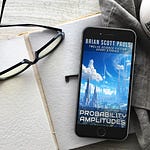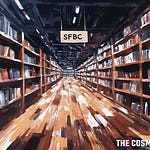
by Brian Scott Pauls
Probability Amplitudes is moving toward publication. In the meantime, I thought readers might appreciate a sample. This has also given me the opportunity to experiment with other forms of storytelling than a book can offer.
I’ve created a multimedia version of my flash fiction piece Chthonic Echoes. Stranded on a harsh world, seeking shelter until help arrives, three castaways wrestle with mysteries that may be critical to their survival. Chthonic Echoes won a writing contest on Wattpad’s @ScienceFiction channel.
I've learned my project re-creates a type of Japanese storytelling called “kamishibai”. This was “…a form of Japanese street theater and storytelling that was popular during the Great Depression of the 1930s and the post-war period in Japan until the advent of television during the mid-20th century.” Kamishibai was “…performed by a ["narrator"] who travelled to street corners with sets of illustrated boards that they placed in a miniature stage-like device and narrated the story by changing each image .” Kamishibai is “…believed to be the precursor to Japan’s manga and anime.”
Instead of “illustrated boards”, I’ve created digital illustrations using Midjourney.
Here’s the result:
If you prefer reading to watching/listening, here is the full text of the story:
Chthonic Echoes
by Brian Scott Pauls
Crew Journal (Spacer Apprentice Adeel Javed)
Day 23, 11:52 Local Time
We’re going into the cave. Getting to be way too much UV out in the suns.Gisele wanted to check out the cave as soon as we found it, and Dr. Ibori said we shouldn’t stay in the open much longer. I didn’t want to let them know how I get in tight spaces, so I didn’t say anything.
12:11
The place turned my stomach the moment Dr. Ibori showed it to us. We had to push through those white, fleshy vines just to get inside. It made my skin crawl when they moved. I swear they were grabbing at me ‘til the doctor used my stun rod to open a hole. The way they pulled back, I guess they didn't like the shock.12:24
Dr. Ibori wouldn't let Gisele explore alone. No way I was going. Told them I'd watch our base camp, close to the entrance.I was sure they'd give up after a few trips, but then Gisele found the diamond.
Damn thing was the size of her fist. She kept turning it over, talking with the doctor, insisting they go see if they could find more.
12:32
The more the UV increases outside, the more the vines move. Head's starting to spin. I hope they come back soon.Medical Journal (Doctor Rafa Ibori)
Day 24, 00:42 Local Time
The growths at the cave mouth are similar to some type of surface-bound tuber, but their cell structure has the elongated shape of myocytes--very similar to terrestrial muscle tissue. This may be a key to the nastic movement we observed when we entered the cave.Where do they get their energy? The planet doesn't receive enough radiation from its small, reddish sun to drive photosynthesis like we see on Earth, and the white dwarf cannot be a factor in daily life. The two stars orbit one another every 25 million years. As they near closest approach, the white sun's influence is wholly negative. We've seen examples from hibernation to encystment of lifeforms seeking shelter to escape the onslaught of ultraviolet light. Yet the tubers are living creatures. They must feed.
Specialist Journal (Doctor Gisele Simard)
Day 24, 00:44 Local Time
It's a diamond—an artificial diamond. Who made it, and why?I wanted to climb the chimney where we found it, but Rafa insisted we return to camp. At least it gave me a chance to examine the sample. It's a perfect octahedron. Half the stone is a hazy gray. The other half is clear, but contains a hologram in the same gray color--an intricate network of branching gray lines forming a hollow sphere. The first time I saw the hologram, something itched at the back of my memory. Rafa was the one who cleared up the mystery. The design most resembles the blood-vessel network of the human eye.
Ibori, 01:11
Where it ends, the passage in which we found the diamond turns into a shaft extending upward. I tried to dissuade Dr. Simard, but she took the climbing gear and went up alone. She must see if there are more diamonds above.Simard, 01:22
Resting. It's a tough climb.Rafa was upset when I left. He thinks we should just wait for rescue.
Simard, 01:42
I've reached the top. This cave system is on a fault line. A million years ago, a quake split the limestone and thrust the strata in front of me upward, wrenching this part of the tunnel into a vertical orientation and exposing a much older slate layer. When I emerged from the chimney, I nearly tumbled into an abyss. Across from me, too far away to reach, the gray-black slate glitters with the reflections from thousands of diamonds.Fortunately, the stone Rafa and I found at the bottom wasn't the only one cast free during the long-ago quake. Several more are scattered about the wide limestone shelf where the chimney emerges. All appeared identical until I inspected the holograms. Each hologram is unique. Like a signature. Or a fingerprint.
Simard, 01:51
I know what the diamonds are.We use diamond storage in the lab. The amount of data that could be written in the hazy, gray half of each octahedron is massive. It could be anything. But there are so many stones—each with a unique biological identifier, as if keyed to an individual. We only have one process that produces anywhere near that amount of data specific to a particular person—when we map the neural network in the brain.
The slate layer is a half billion years old—maybe 20 passes of the red dwarf and its planet through the hellish ultraviolet of their white companion. A periodic apocalypse that must nearly sterilize the planet, including any civilization that has arisen in the past 25 million years. Individuals might survive, but not for long without a functioning ecology. The biosphere itself might turn on them as every organism struggles to survive.
How long would it take the life of this world to re-establish a stable environment once the remnants emerged from their holes and cocoons? How long until intelligence awoke again? How many civilizations have risen and fallen on this planet of death?
But diamond storage can last billions of years. These people chose to preserve their very memory, for some bleak possibility of future rescue. What sort of species evolves on a planet as unforgiving as this? For good or ill, they await resurrection.
Rafa is calling me.
Javed, 02:07
The vines are in the cave now, between me and the mouth. They can tell where I am. I can't go deeper into the cave. I can't.I hope the others come back soon. The charge in the stun rod is low.
I hope you’ve enjoyed this sample of my fiction. When released, Probability Amplitudes, will include Chthonic Echoes and other stories. I would love to get your feedback on either of these projects!
Please share your thoughts about this article by commenting online at thecosmiccodex.com!














Share this post